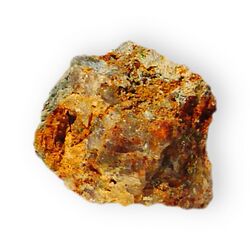Chemistry:Zeunerite
From HandWiki
| Zeunerite | |
|---|---|
 | |
| General | |
| Category | Arsenate mineral |
| Formula (repeating unit) | Cu(UO2)2(AsO4)2·(10-16)H2O |
| Strunz classification | 8.EB.05 |
| Dana classification | 40.02a.14.01 |
| Crystal system | Tetragonal |
| Crystal class | Ditetragonal dipyramidal (4/mmm) H-M symbol: (4/m 2/m 2/m) |
| Space group | P4/nnc |
| Identification | |
| Color | Yellow-green, emerald-green |
| Crystal habit | Crystals flat tabular on {001}, commonly subparallel to micaceous |
| Cleavage | {001} perfect, {100}, distinct |
| Mohs scale hardness | 2.5 |
| |re|er}} | Vitreous |
| Streak | pale green |
| Diaphaneity | Transparent, becoming translucent on dehydration |
| Specific gravity | 3.2–3.4 |
| Optical properties | Uniaxial (−) |
| Refractive index | nω = 1.610 – 1.613 nε = 1.582 – 1.585 |
| Birefringence | δ = 0.028 |
| Pleochroism | Visible |
| Other characteristics | |
| References | [1][2][3] |
Zeunerite is a green copper uranium arsenate mineral with formula Cu(UO2)2(AsO4)2·(10-16)H2O. It is a member of the autunite group. The associated mineral metazeunerite is a dehydration product of zeunerite.
Zeunerite occurs as a secondary mineral in the oxidized weathering zone of hydrothermal uranium ore deposits which contain arsenic. Olivenite, mansfieldite, scorodite, azurite and malachite are found in association with zeunerite.[1]
It was first described in 1872 for an occurrence in the Schneeberg District, Ore Mountains, Saxony, Germany. It was named for Gustav Anton Zeuner (1828–1907).[2]
References
- ↑ 1.0 1.1 Handbook of Mineralogy
- ↑ 2.0 2.1 Mindat
- ↑ Webmineral data
- ↑ Warr, L.N. (2021). "IMA–CNMNC approved mineral symbols". Mineralogical Magazine 85 (3): 291–320. doi:10.1180/mgm.2021.43. Bibcode: 2021MinM...85..291W.
 |

